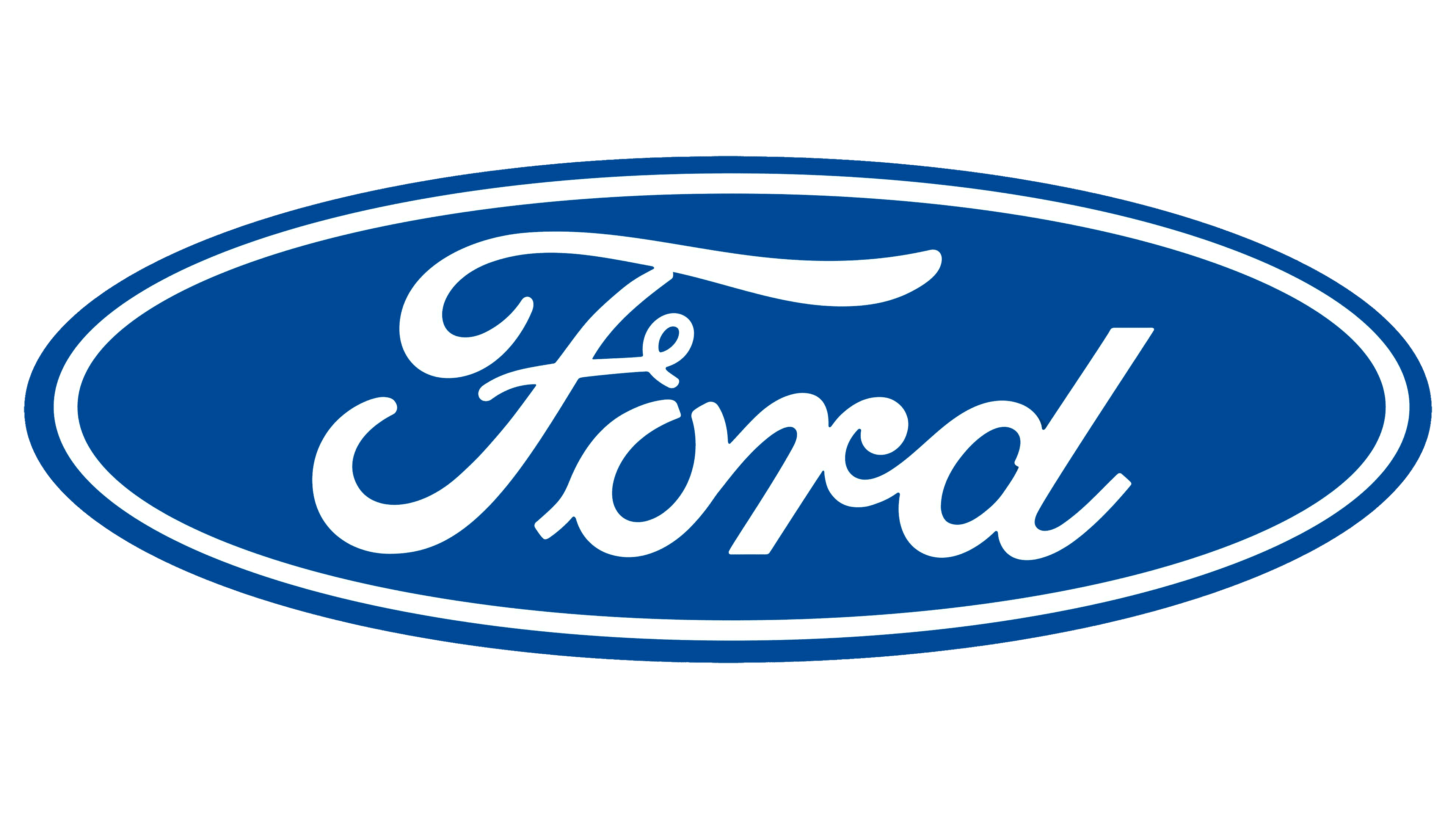Amongst the American car producers, Ford is easily a #1 brand. It was launched back in 1903 by Henry Ford, now considered one of the most prominent pioneers of car manufacturing. Still being one of the top car producers in the world, the company has a surprisingly dull logo, as you’ll see.
Meaning and History
As mentioned, Ford was launched in 1903 – more than 110 years ago. The meaning behind the company name is simple. It obviously mirrors the name of the founder and long-time CEO Henry Ford. It’s virtually the only valuable detail on the logo’s design, at least in recent history.
1903 – 1907
Nowadays the logo is basically a blue badge with the name of the founder on it. Back in the day, however, it was fairly more detailed.
The first logo was actually a black asymmetric badge, surrounded by a kind of decorative white frame. It’s very irregular and gives out a natural vibe, which is a bit contradictory to the purpose of the company.
Right on the badge, you can see a white text saying ‘Ford Motor Co.’ in a curvy artistic way. In contrast, there is another text with the location of the company – Detroit, Mich. (Michigan) – right below the main text.
1907 – 1909
For two years between 1907 and 1907 the company had a silvery badge, shaped like an American football (which may be intentional). The word ‘Ford’ is confined in the center of the badge and widened in the middle due to the position of inner lines on the logo.
Above the oval-like formation created by the lines were several words – from left to right: ‘FOR QUALITY’, ‘HALL MARK’, ‘AND ECONOMY’. The first and the third form the contemporary motto.
On the opposite side was another piece of text, which said: ‘EVERY CAR GUARARANTEED TWELVE MONTHS’. And the error wasn’t the only imperfection – the ‘GUARARANTED’ word was also noticeably shifted from the center. It’s unsurprising that the design was changed mere 2 years later.
1909 – 1911
The 1909 version was the first instance of using the now-iconic text style by this company. The similar artistic signature-like name was used since then on almost every Ford logo.
The only two major differences, the first was the underlining stroke, starting from the end of the last letter and ending right below the first one. The second were the quotation marks (‘’Ford’’), in which the black word was put, for some reason.
1911 – 1912
In this version the name was given its final look. The letter ‘r’ was reversed and the font became less curvy and thin. So, it was a bit bolder and had a few white specks, as if resembling lighting.
The name was encircled by a line that formed an oval shape. The words ‘the famous’ was above it, while the words ‘motor cars’ were below. This text, along with everything else, was further encircled by the similar oval line.
This version wasn’t unlike the logo we have now, but back then the experiments continued.
1912 – 1917
In 1912, Ford tried another approach. He wrote his name in a clean white way (the style remained the same), but this time it was on the blue bird-like badge. On the left and right on the word the big wings were spread out, and they had a few cone-like lines coming from the outside. This portrayed the space between the feathers.
If you focus on the middle of the picture, you’ll see that the ‘beak’ and the wide ‘tail’ form one triangle that fuses in the center with the wings (which in themselves are just a half-circle). As a result, you get a winged triangle. It’s an economic way to create a logo, but it still got the point of speed across.
In terms of details, the tails also depicts a smaller ‘Universal Car’ writing on it, and the whole image is also framed by a double line of white and blue colors.
1917 – 1927
In 1917 Ford finally decided on the image that the brand also wears today. It was a canonic name put into a simple white oval with the black edges. The text was also black, which gave the whole logo a very simplistic look.
1927 – 1957
So, for 40 years between 1917 and 1957, the composition was the same. The only thing that changed in 1927 was the color palette. The word became white, and its background was given a nice blue color which the company largely uses even today.
The edges of the logo also changed color. The thin blue outer line was combined with the wider inner white ring. This detail is also a big inspiration for the modern versions of the corporal image.
1957 – 1961
For several years, the logo was returned to its weird football shape. Everything pretty much remained the same in this version, but the edges that touched the diagonals were for some reason squeezed. The color was also a bit paler, but that’s it.
1961 – 1965
Then, the badge was pretty much returned to the oval shape. There were differences, like the much darker color blue, and the additional white and blue layers of outline. However, it was just a slight experimentation – the company regularly changed the details in such slight ways.
The spirit and the composition of the logo, however, remained the same from here on.
1965 – now
1965 saw the company introduce the modern logo, the primary one they use now. It was a bit thinner than the 1927 version. The color was much more pleasant – a standard comfortable blue. The blue outline was also noticeable thicker, while the inner a white layer was still present.
After the introduction of this new version, the company also introduced several additional badges for the cars. These were used simultaneously, but with different levels priority.
In 1976 this version has become second-rate, although it made comeback in 2017.
1976 – 2003
The logo was first given a chrome look and an additional metallic ring around the badge. This one was obviously developed specifically for use on the cars. It was sometimes summoned to portray the company itself, but there were other logos for it.
2000 – 2003 (writing)
This was exactly the occasion was this writing logo. For 3 years, there was another logo used in parallel with the other 2. This one, however, was featured mostly to represent the brand on anything other than the front or the interior of the cars.
It was a dark blue writing that said ‘Ford Motor Company’ in the same font and style that resembled Ford’s own signature. It was scrapped very quickly in favor of yet another badge.
2003 – 2017
Well, this recent one was pretty much the 1965 variant, but with lighting – the light came as if from above. Because of it, the bottom of the badge looked darker, and the top was seemingly lighter than before. In 2017 it was also scrapped, and the more simplistic look from 1965 was primary once again.
After all this deliberation and struggle with virtually the same design, Ford made a full circle. Hopefully, they won’t be changing the current design for some time, because it’s the cleanest and prettiest of them all.
The Legends
Ford Model T is easily the most influential car in the world, not to mention America. It was the first car that an average American can afford, all thanks to the Ford’s innovative solutions about car production and assembly.
The engine was a 4-cilinder marvel that could take car to the maximum speed of 70 km/h (a very result for the contemporary standards). This, and the price, made Ford’s T into a symbol of American dream.
The Concept Cars
Ford has created many prototype cars over the years, but probably the most interesting destination they took was their work on the futuristic cars.
The most recent, a 2007 Airstream is a hybrid hydrogen-powered wagon with two doors. Its exterior design captures the attention specifically, because it was inspired by the spacecraft of the time. In essence, they made the car look plastic and removed nearly all sharp angles.
Ford Race Cars
Ford is the only American car manufacturer to have won a race on Le Mans. In fact, they won 4 consecutive races in 1966-1969, which puts them on the sixth place alongside Alfa Romeo.
The thing that got them this fame was the Ford GT40, or just GT. It was the first real race car built by Ford, and they did their job – they took the lead away from Ferrari.
After that, the Italians never won at Le Mans again. Neither did Ford, however, because they didn’t take the Germans into account, and they’ve been winning at Le Mans almost without opposition since 1970.















